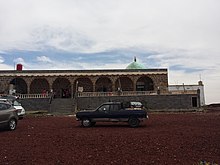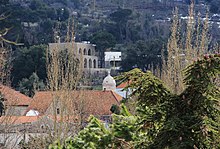Christianity and other religions
The liberalization of many seminaries and theological institutions, particularly in regards to the rejection of the notion that the Bible is an infallible document, has led to a much more human-centered and secular movement within Mainline Christian denominations, particularly in the United States.
The Second Vatican Council states that salvation includes others who acknowledge the same creator, and explicitly lists Muslims among those (using the term Mohammedans, which was the word commonly used among non-Muslims at the time).
These meetings, consisting of round tables on different issues and of a common time of prayer, have done much to further understanding and friendship between religious leaders and to further concrete peace initiatives.
However, this decision was partially reversed by Pope Pius XII in 1939; after this, Chinese customs were no longer considered superstition or idolatry, but a way of honoring esteemed relatives (not entirely dissimilar to the Catholic practice of praying for the dead).
Rhys Davids wrote that the earliest missionaries to Tibet observed that similarities have been seen in Christianity and Buddhism since the first known contact was made between adherents of the two religions.
The relationship between the Druze and Christians has been characterized by harmony and peaceful coexistence,[10][11][12][13] with amicable relations between the two groups prevailing throughout history, with the exception of some periods, including 1860 Mount Lebanon civil war.
[61] Historians notes that the Druze have historically maintained a positive relationship with Christians, as evidenced by shared traditions and social practices in Mount Lebanon.
From the Hindu perspective, heaven (Sanskrit svarga) and hell (Naraka) are temporary places, where every soul has to live, either for the good deeds which they have done or for the sins which they have committed.
On one hand, Hinduism's natural tendency has been to recognize the divine basis of various other religions, and to revere their founders and saintly practitioners.
[76] The position has remained popular in Christian circles well into the 20th century, by theologians such as the Congregationalist cleric Frank Hugh Foster and the Roman Catholic historian Hilaire Belloc, the latter of who described it as "the great and enduring heresy of Mohammed.
For example, with the exception of Messianic Islam and sometimes Koranism, Muslims in general on an anti-Catholic basis reject belief in the Trinity or any other expression of the divinity of Jesus as incompatible with monotheism.
Not surprisingly, the two faiths have often experienced mutual controversy and conflict (an example being the Crusades, fought in response to Islamic conquests and attitudes to non-Muslims, in the near and Middle East).
The writings of Catholic theologian Thomas Aquinas frequently cite those of the Jewish philosopher Moses Maimonides, as well as Muslim thinker Averroes ('Ibn-Rushd).
The Pew Forum study finds that Indonesia (21.1 million) has the largest Christian population in the Muslim world, followed by Egypt, Chad and Kazakhstan.
Better mutual understanding will surely lead, at the practical level, to a new way of presenting our two religions not in opposition, as has happened too often in the past, but in partnership for the good of the human family."
In the past, Christians were often taught that "the Jews" killed Christ, for whose "murder" they bear a collective guilt (an interpretation which most major denominations now reject).
According to Anna Sapir Abulafia, most scholars agree that Jews and Christians in Latin Christendom lived in relative peace with one another until the 13th century.
[89] The first papal bull was issued in about 1120 by Calixtus II, intended to protect Jews who suffered during the First Crusade, and was reaffirmed by many popes, even until the 15th century although they were not always strictly upheld.
The bull forbade, besides other things, Christians from coercing Jews to convert, or to harm them, or to take their property, or to disturb the celebration of their festivals, or to interfere with their cemeteries, on pain of excommunication.
[91] Other similarities include the stories of Christ and Mithra as children being visited by shepherds, the trinity, and the immortal soul[citation needed].
(Although Christians worshiped on Sunday from at least 150 years before Constantine)[92] The earliest attestation of Mithraism is Plutarch's record of it being practised in 68BC by Cilician pirates, the first mithraists.
[98] Professor Paul Blankenship of the Memphis Theological Seminary studied Scientology and commented on this view, saying "They do not do a lot of talking about God or Jesus.
[100] In the book New Religions and the Theological Imagination in America (1995) by Mary Farrell Bednarowski, the author comments that "In the game of life as Scientology understands it, sin does not call for repentance as much as it does the eradication of error, and that must come through the technology, the auditing process, sometimes referred to as pastoral counseling.
[101] Writing in Signs of the Times: The New Religious Movements in Theological Perspective (1996), John A. Saliba cites Mary Bednarowski, and goes on to note "Helle Medgaard asserts that Scientology also misunderstands Jesus and repudiates the key Christian doctrine of the forgiveness of sins.
"[102] In his book The Sociology of Religious Movements (1996), William Sims Bainbridge cites the research of Roy Wallis, in noting "Scientology ... has no discernible connection to Christianity".
During this time Zoroastrianism profoundly effected the beliefs and values of Judaism, Christianity, and Islam ("Traditions & Encounters: A brief global History", Jerry H. Bentley.
Similarities with the Christian Trinity can be seen between Ahura Mazda and God the Father, Mithra and Christ the Logos, as well as between Burz and the Holy Spirit, both of which are associated symbolically with water.
There have been various theories on the possible relationship between these aspects of Zoroastrianism and ideas of divine emanation in esoteric Christianity, Jewish Kabbalah, Islamic mysticism (Sufism), and other religious systems, such as Gnosticism, Yazidism, and the Druze, among others.
The newspaper Guardian, which dedicated the double middle page of the following day's issue to a full picture of the grinning archbishop in full apparel at the porch of the cathedral, said that: "Dr Sentamu's sermon was a stern lecture to the Church of England to grow out of being a 'judgmental and moralising' congregation of 'pew-fillers, sermon-taters, Bible readers, even born-again believers and Spirit-filled charismatics' and go out to make friends in the world.
'Christians, go and make friends among Buddhists, Hindus, Jews, Muslims, Sikhs, agnostics, atheists, not for the purpose of converting them to your beliefs but for friendship, understanding, listening, hearing.'



